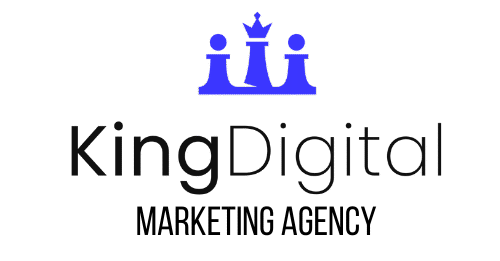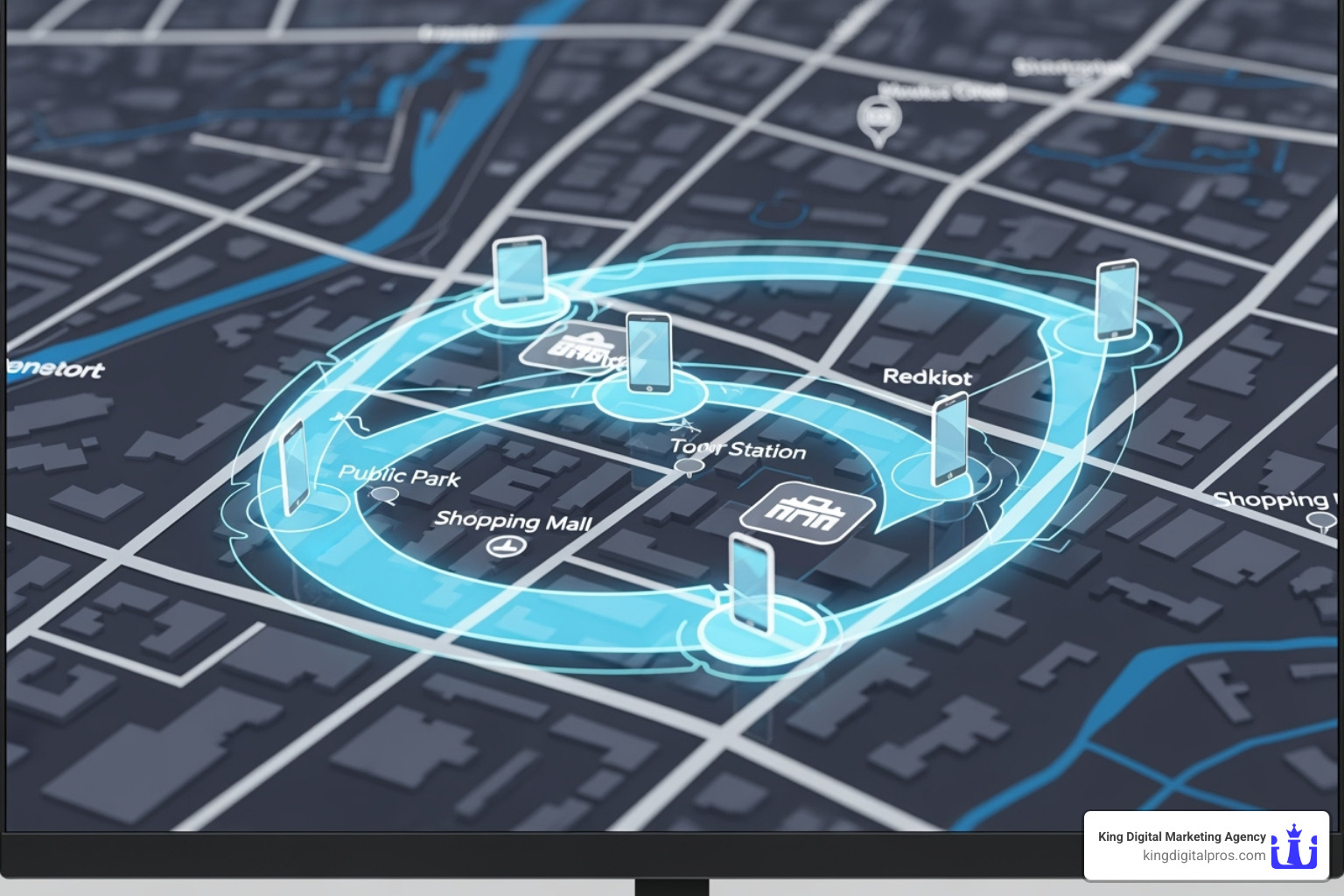What is Geofencing Software and Why It Matters for Your Business
Geofencing software creates virtual boundaries around real-world locations, triggering automated actions when mobile devices enter or exit these zones. This technology helps businesses deliver targeted messages, track assets, and engage customers at precisely the right moment and place.
Quick Answer for “Geofencing Software”:
- Definition: Location-based technology that creates virtual perimeters around physical areas
- How it works: Uses GPS, Wi-Fi, or cellular data to detect when devices cross boundaries
- Key benefits: Hyper-local marketing, improved customer engagement, operational efficiency
- Common uses: Push notifications, asset tracking, workforce management, targeted advertising
- Accuracy: Ranges from 5-10 feet (optimal conditions) to 100-200 meters (cellular-based)
- Privacy: Requires user consent and follows regulations like GDPR and CCPA
For local businesses struggling with online visibility, geofencing offers a powerful solution. Instead of hoping customers find you through map listings, you can actively reach them when they’re nearby – whether walking past your store, visiting a competitor, or attending a local event.
The technology has evolved far beyond simple alerts. Today’s platforms can achieve accuracy down to five meters, and geo ads are 20 times more effective than traditional advertising, making this a game-changer for maximizing marketing budgets.
I’m Bernadette King, founder of King Digital Marketing Agency. I’ve helped countless local businesses leverage geofencing to transform their customer acquisition strategy, turning location data into measurable growth.

What is Geofencing and How Does It Work?
Ever walked past a coffee shop and received a timely 20% off coupon on your phone? That’s geofencing software at work. It creates invisible boundaries around real-world locations using GPS coordinates. When a mobile device crosses these virtual fences, it triggers actions like sending push notifications or logging visits.
With over 81% of American consumers carrying smartphones, most of which are compatible with geofencing, businesses have a direct line to customers at the perfect moment. Setting it up is straightforward: you use a software platform to draw boundaries on a digital map, from simple circles to complex shapes outlining entire districts. Once active, the geofence works through mobile apps on users’ devices.
The key is user consent. People must opt-in by enabling location services for an app, ensuring privacy while granting you permission to deliver relevant messages. For more technical details, you can explore more about geofencing technology.
The Technology Behind the Boundary
Geofencing software uses a mix of location technologies. GPS is ideal for outdoor accuracy but struggles indoors. Wi-Fi positioning excels inside buildings by scanning nearby hotspots. Cellular data provides broader, less precise coverage as a reliable backup. For specialized uses, RFID tags track assets in warehouses, and Bluetooth guides (guides) offer hyper-precise indoor tracking, sometimes accurate to within a few feet.
Accuracy varies from 100-200 meters with cellular tracking to within five meters with advanced solutions. While battery consumption was once a concern, modern software is optimized for efficiency and won’t drain customers’ phones.
Understanding the Core Functionality of Geofencing Software
The magic happens when devices interact with your virtual boundaries. Core functions include:
- Entry Triggers: These are the most common, sending an offer when a customer nears your store.
- Exit Triggers: These activate when someone leaves, perfect for a “thanks for visiting” message.
- Dwell Time: This tracks how long a device stays in an area, offering valuable intelligence for targeted follow-ups.
These actions power real-time alerts for operations (like equipment leaving a site) and marketing messages, such as push notifications or in-app messages, which appear when a user opens your app inside the geofence. Since the average user gets 46 push notifications daily, the location context of geofencing makes your message stand out as relevant and valuable.
The Transformative Benefits of Geofencing for Businesses
Geofencing helps businesses reach customers at exactly the right moment, creating meaningful connections that drive real results. It’s not about sending random notifications; it’s about helpful timing and adding value.

Boosting Marketing and Customer Engagement
Geofencing excels at hyper-local targeting, reaching people when they are most likely to buy. This leads to powerful benefits:
- Increased Foot Traffic: By sending timely offers to people nearby, businesses can see significant boosts in walk-in customers. One of our clients saw a 35% increase after implementing a strategic geofencing campaign.
- Improved Customer Loyalty: Consistently providing value at the right moment builds a positive brand perception and encourages repeat visits.
- Higher Conversion Rates: Reaching customers who are already in a buying mindset dramatically increases the likelihood they’ll act on an offer.
- Competitive Advantage: Target customers near competitor locations to give them a compelling reason to visit you instead. This is a key strategy in our Geofencing Marketing Services.
Improving Operational Efficiency and Asset Management
Beyond marketing, geofencing streamlines internal operations, saving time and money.
Workforce tracking automates employee check-ins at job sites, creating accurate, automated time-sheets and eliminating disputes. For logistics, fleet management uses geofencing to monitor vehicle routes and driver behavior, improving efficiency and customer service.
Asset security is another key benefit. You can receive instant alerts if valuable equipment leaves a designated area, enabling proactive theft prevention. This visibility optimizes logistics, with some companies saving over $150,000 annually by better tracking equipment usage. When combined with our Lead Tracking Services, these operational insights create a full-funnel view of your business.
Real-World Applications Across Key Industries
The versatility of geofencing software has led to its adoption across a wide array of industries, each leveraging its capabilities in unique ways.

Retail and Quick-Service Restaurants (QSR)
In Retail and QSR, geofencing powers curbside pickup alerts and drive-thru optimization, reducing wait times by sequencing orders based on customer arrival. It also enables timely in-store promotions and competitor conquesting by sending offers to customers near a rival’s location. This strategy is highly effective for businesses looking to Attract Customers Via Google Maps by converting local searches into immediate visits.
Logistics, Construction, and Field Services
For Logistics, Construction, and Field Services, geofencing is essential for route optimization and real-time vehicle tracking. In construction, it provides critical equipment monitoring to prevent theft and ensures job site safety by creating virtual boundaries around hazardous areas. The system also automates proof of delivery, creating a reliable digital record. Integrating these insights with Sales Lead Management ensures timely follow-ups based on a prospect’s physical location.
Events, Hospitality, and Security
In Events and Hospitality, geofencing improves the guest experience with automated check-ins, digital room keys, and targeted event information. For Security, it enables seamless access control and allows for targeted emergency alerts during crises. It’s also used for fraud prevention in financial services and gaming by verifying user locations, a process that must comply with data privacy regulations.
Key Features to Look for in Geofencing Software
When choosing geofencing software, focus on the features that matter most for your business goals. The foundation is real-time location tracking and the ability to create dynamic, custom-shaped geofences that match your physical boundaries. Essential functions include entry/exit notifications and robust analytical capabilities to measure dwell time and foot traffic. Prioritize platforms with strong encryption and consent mechanisms to comply with privacy regulations like GDPR, and ensure the software is scalable to grow with your business.
How to Choose the Right Geofencing Software for Your Business
To choose the right software, start with your specific goals and look for these key attributes:
- Scalability: Can the platform handle your future growth in terms of users, devices, and locations?
- Ease of Use: Is the dashboard intuitive for your team to manage campaigns without extensive training?
- Customization: Can you create custom-shaped fences, segment audiences, and tailor messages?
- Integration: Does it offer APIs and SDKs to connect with your existing CRM and marketing tools? A well-integrated system is key for Conversion Optimization.
Analytics, Reporting, and ROI
The true value of geofencing lies in its analytics. Look for platforms that provide:
- Dashboards: An at-a-glance view of key performance indicators (KPIs).
- Heatmaps: Visuals showing customer movement and high-traffic zones.
- Foot Traffic Analysis: Connects digital campaigns to in-store visits to measure lift.
- A/B Testing: To optimize messages, timing, and offers for better performance.
- Attribution Models: To clearly measure ROI and understand which campaigns drive sales. Our Lead Value Calculator can help quantify this potential return.
Understanding Pricing Models and Costs
Pricing models for geofencing software vary. Common structures include subscription tiers (e.g., Basic, Pro, Enterprise), per-user or per-device fees, and usage-based pricing (charging per API call or notification). Many providers offer free trials for testing. Always clarify potential hidden costs for integrations, support, or overage fees. Plans can range from $10 to over $500 monthly, but the investment is often justified by the high ROI of geo-targeted ads.
Frequently Asked Questions about Geofencing Software
Here are answers to the most common questions business owners ask about geofencing software.
How accurate is geofencing?
Accuracy depends on the technology and environment. Advanced GPS and Bluetooth guides can be precise to within a few meters, ideal for in-store actions. Cellular and Wi-Fi-based geofencing covers broader areas (100-200 meters), which is effective for neighborhood-level targeting. Factors like being indoors versus outdoors and user device settings also affect precision, but most marketing goals are achievable with standard accuracy.
Is geofencing an invasion of privacy?
No, when implemented ethically. Geofencing is consent-based, meaning users must opt-in by enabling location services. Reputable platforms comply with privacy laws like GDPR in Europe and CCPA, anonymizing data. The software tracks a device ID, not a person’s identity, and this data is not sold. Transparency with users about how their data is used is crucial.
Can geofencing work without a mobile app?
Primarily, geofencing requires a mobile app with an integrated SDK for the most accurate tracking and features like push notifications. However, app-less geofencing exists for advertising purposes. It targets users within a geofence through mobile web browsers and ad networks. This method is generally less precise and offers fewer trigger options, making the app-based approach superior for most businesses seeking direct engagement and higher ROI.
The Future of Geofencing: Trends and Predictions
The future of geofencing software is being shaped by several key trends. Artificial intelligence and machine learning are enabling hyper-personalization, allowing businesses to predict customer needs and send relevant offers based on past behavior and real-time context. Integration with IoT devices, from smart cars to fitness trackers, will create even more seamless, automated experiences.
As capabilities expand, improved privacy controls will become paramount, giving users transparent and easy-to-use options to manage their data, in line with regulations like GDPR. The most significant trend may be predictive location analytics, which will allow businesses to anticipate customer arrivals and proactively prepare for their needs, changing service from reactive to proactive.
At King Digital Marketing Agency, we’re passionate about helping businesses leverage these emerging technologies to stay ahead of the curve. The future of customer engagement isn’t just about being present—it’s about being present at the right moment with the right message.
Let us help you steer this exciting landscape and turn location data into meaningful customer relationships. Explore our geofencing marketing services to see how we can help your business prepare for what’s next, or check out our digital marketing blog for the latest insights.

